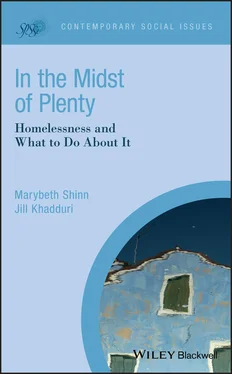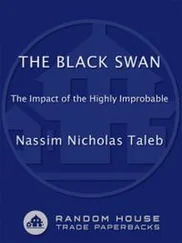But my experience leads me to believe that it is neither inevitable nor unsolvable in a nation with the resources and capacity of ours. And the knowledgeable and thoughtful authors of this book—two brilliant women who know as much as anyone in the country about the nature of homelessness and its solutions—have done a great service by taking us on a journey through the history of homelessness, how our responses have changed, and how we can end it.
Chapter 1describes the problem of homelessness in terms of the number, characteristics and trajectories of people who experience it. It describes how people use the various programs that constitute the emerging homelessness system, and looks at how this system has changed over time. It also reflects on the very important fact that homelessness is an experience that a wide variety of mostly poor people face: not a characteristic that defines a person.
In Chapter 2the authors explore whether homelessness is the result of personal characteristics or outside factors—or an interaction of the two. Here they make the case that housing affordability (a combination of the cost of housing and people's incomes), while not accounting for everything, is the primary driver of homelessness to which personal characteristics or experiences (mental illness, gender identity, criminal records, etc.) contribute. They examine how the U.S. experience of homelessness compares to that of other countries, and why.
Chapter 3looks at what it takes to end homelessness for people who experience it. If homelessness is defined by not having a home, then acquiring a home must be its solution. The authors describe two approaches to providing that home: long‐term housing subsidies for families and individuals whose problem is largely affordability; and permanent supportive housing (also referred to as Housing First and Pathways to Housing) which provides a long‐term housing subsidy plus services to people with chronic health disorders. They also look at what services people may need to maintain their housing. Chapter 4explores how the various homelessness interventions are being brought together into homelessness systems, with the goal of coordinating resources to reduce and end homelessness. The authors point out the strong and weak elements of these systems and the challenges not only of delivering quality assistance, but delivering it to scale.
Getting people who have become homeless back into housing is one way to solve the problem. Another is to prevent them from becoming homeless in the first place. Chapter 5explores this option, pointing out that prevention must first figure out who is going to become homeless and then intervene in a way that stops them from having that experience (the first being harder to achieve than the second). Housing‐focused prevention is examined, as is preventing homelessness for people exiting public systems such as foster care and criminal justice, and geographic targeting.
Finally, in Chapter 6the authors present a more wide‐ranging vision of a social contract that would ensure all the people of our nation could afford decent housing. They propose various ways to accomplish this from both the housing and the income side. They also point out that making sure people have resources to support a decent standard of living would help to mitigate other problems such as racial discrimination. And they recognize that ensuring everyone has decent affordable housing will require significant political will: will that has not been present over the past 30 years of widespread national homelessness.
Marybeth Shinn and Jill Khadduri have provided us with a full‐fledged history of homelessness and what has been done about it—successfully and otherwise. They make a strong case that ensuring the most vulnerable people have safe, decent and affordable housing would probably cost less and certainly yield far more than allowing tens of thousands of people to become homeless every year. Their wise and educated voices provide a rational vision of how homelessness can be ended. It is to be hoped that this vision will be widely adopted.
Nan Roman
President and CEO of the National Alliance to End Homelessness
Many people helped improve the quality of this book—its accuracy, its clarity, the force of its presentation.
Four people were kind enough to read the entire manuscript, and they made helpful comments and corrections throughout: Paul Dornan, formerly responsible for research on homelessness at the U.S. Department of Housing and Urban Development (HUD); Lucie Khadduri, who lives in Olympia WA, a city with a recent upsurge in homelessness; Daniel Perlman, Series Editor for the Society for the Psychological Study of Social Issues, who provided encouragement throughout the book's long gestation period; and Nan Roman, President and CEO of the National Alliance to End Homelessness. Zach Glendening, Molly Richard, and Jason Rodriguez at Vanderbilt University read portions of the manuscript and provided comments that improved clarity and pointed to additional sources of information.
Meghan Henry, project director for the Annual Homeless Assessment Reports at Abt Associates, commented extensively on Chapter 1and confirmed numbers. John Miller, an experienced journalist, also read Chapter 1and, along with Meghan, helped us make the chapter more readable. Jill's Abt colleagues Anna Jefferson and Hannah Thomas helped identify and expand the vignettes about people experiencing homelessness that begin Chapter 1. Sally B. Lott described her work as a housing navigator in Chapter 5. Kathryn P. Nelson, who designed HUD's ongoing reports on “worst case” housing problems and needs for assistance, read Chapter 2and suggested additions and corrections. Barbara Sard of the Center on Budget and Policy Priorities read Chapter 6and provided comments on the housing side of the social safety net. She also enlisted her colleagues at the Center to review portions of Chapter 6on the income side of the safety net: Ed Bolen, Brendan Duke, Chye‐Ching Huang, LaDonna Pavetti, Kathleen Ronig, and Chad Stone. We thank them for their comments and for their identification of literature that we had missed.
Janine Christiano, Gavin Crowell‐Williamson, Kayle DeCant, and Rebecca Huppi provided help with references, and David Krantz drew several of the figures.
Many thanks to them all. As always, all errors belong to us.
Beth was hosted in turn by the Urban Institute and the Rockefeller Foundation Bellagio Center and wrote portions of the book during those visits and during a sabbatical from Vanderbilt.
Jill would like to thank her employer, Abt Associates, for the many research projects on homelessness in which she has participated and for access to wonderful colleagues. Beth had the privilege of working with Jill and Abt colleagues on a couple of these.
And homeless near a thousand homes I stood,
And near a thousand tables pined and wanted food.
William Wordsworth, 1842
(Guilt and Sorrow Verse XLI)
In the late 1980s, The New York Times ran a series of editorials dubbed “New Calcutta,” lamenting the rise of homelessness on New York City streets and urging the City to action (e.g. “New Calcutta,” 1988). The editorial writers may have chosen their foil poorly—wags complained with some justice that the Times was unfair to Calcutta (Gordon, 1989; Roeper, 1989). But the point of the metaphor was clear. How, the Times asked, could such abject poverty be permitted in a wealthy land?
An entire generation has grown up since homelessness spilled out of skid rows and into the nation's consciousness. Young people have no memories of the days when they did not have to pick their way around their fellow citizens dwelling in the streets, and older adults can scarcely recapture their shocked disbelief that homelessness should arise here, in the United States.
Читать дальше












